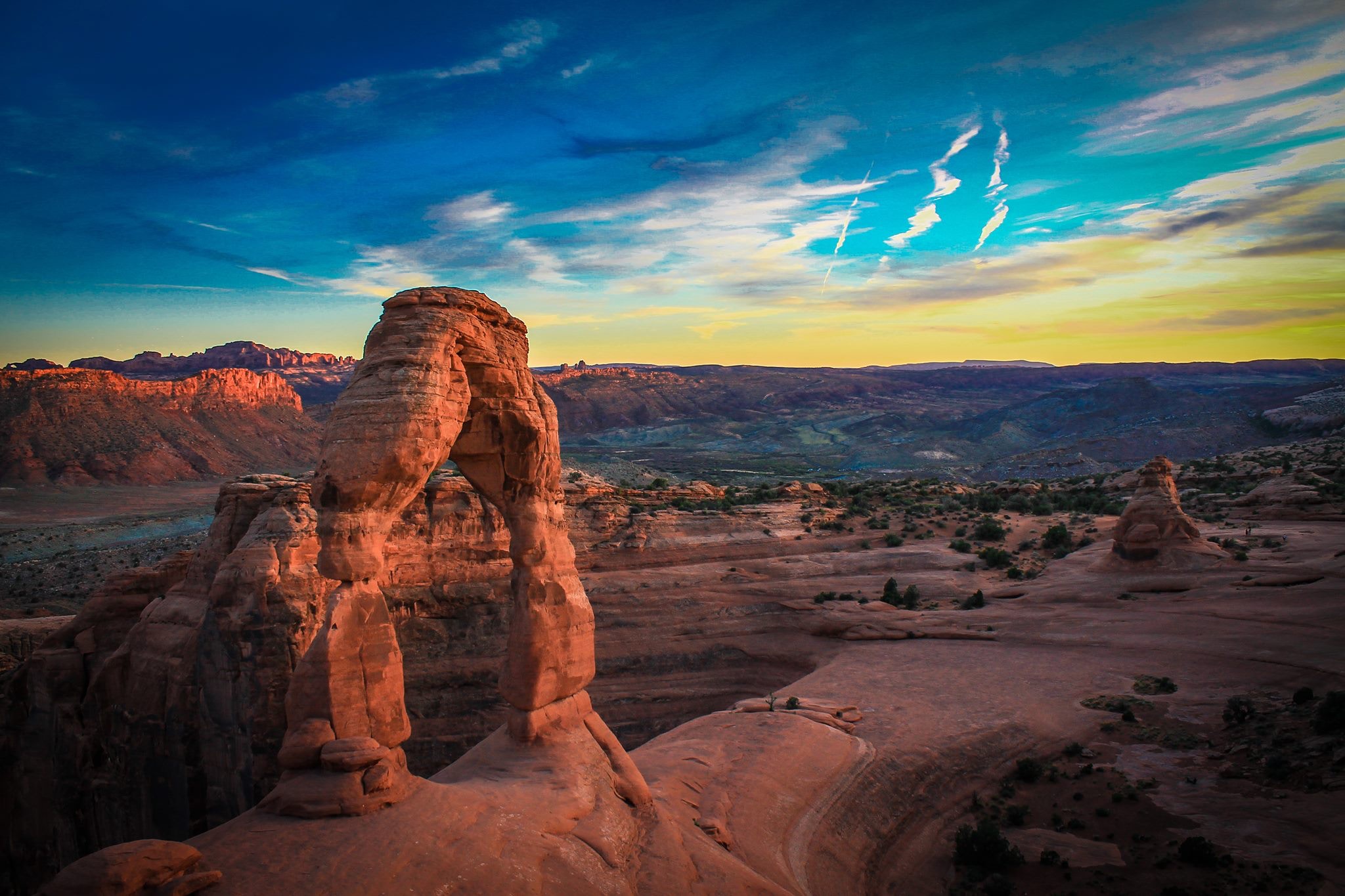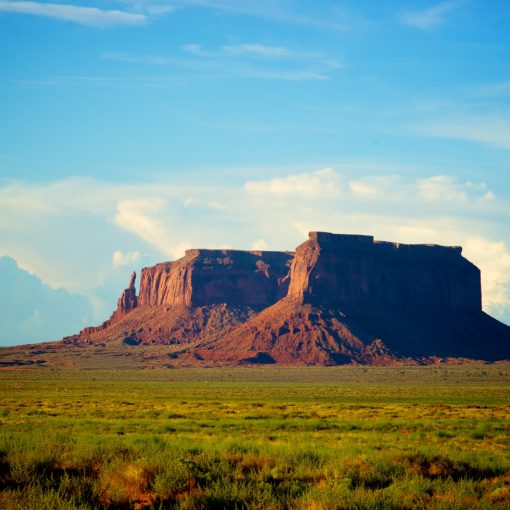As always, the full series is available here.
Untamed and Sun-Baked
The Yuthi desert is an area of The Wilds in terms of my three broad categories of place for the setting. As one might expect from a desert, it is hot, dry, and sunny, but it is also beautiful and surprisingly full of life despite its harshness. It’s closer to the Four Corners region of the American southwest than the Sahara in terms of terrain – arid, but more rocky and mountainous than just endless sand dunes. For reference, see the picture at the top of the post for reference – it’s a very close representation of what the place looks like. There’s quite a bit more to the Yuthi than just stark natural beauty, though.
The Desert Doesn’t Pick Sides
As with most areas of The Wilds, the Yuthi is unaligned. Nature is very much in charge here, and while there are good and evil beings in the region, there’s not enough organized society for there to be any sort of regional alignment or even personality that represents the region as a whole. Nature is impartial. It is, however, often quite beautiful. In addition to the magnificent, sandswept rock formations, some of the local fauna is breathtaking. In particular is a plant the locals call “fire carpet.” A hardy, low-to-the-ground flowering plant, it gets its name from its dense growing pattern and striking bio-luminescent flowers. Fire carpet can be found in a number of shades of red, yellow, orange, and pink, and they tend to blend together, giving the effect of sheets of flame, especially at night and at a distance.
Getting By
Like most deserts, the Yuthi is sparse, but not entirely devoid of life. In addition to normal wildlife like you’d find in a desert, such as owls, foxes, and lizards, one can also find a number of desert-dwelling monsters here, but you can also find a number of sapient races. A large Orc Tribe, the Dry Tusks, lives here in the Yuthi and are the largest and most powerful group in the region. They are nomadic, living in tents and traveling via beast of burden. Fuel is rare this far from civilization, so while the clan could theoretically use vehicles, it would be very impractical to do so. They subsist on desert vegetation and wildlife – on the vegetation side, there are a number of succulents that are edible, including a form of scrub grass that’s digestible to humanoids. The Yuthi has a couple of major rivers running through it, and a spring oasis here and there, so while rain isn’t plentiful, water can be found if one knows where to look.
Notable Locations
The Yuthi is vast, but it contains a lot within its borders.
Klaridian Empire Ruins: The Klaridian empire flourished millennia ago, but ultimately fell due to a series of civil wars and internal collapse. The remains of its great city-states still dot the landscape far from the trade roads that wind through the Yuthi. There’s still a significant amount of treasure to be had in the ruins, but it’s very hazardous to get at. The ruins are guarded by ancient Klaridian mummy warriors, an aggressive tribe of naga called the White Skulls, a family of territorial dragons, and the desert itself. Interestingly, it’s possible that those in significant need could make a deal with the Klaridian guardians – they aren’t so much intent on keeping everything where it is as they are intent on keeping things from being defiled through misuse and simple monetary gain. A group of heroes that approach the guardians in humility and good faith might find some allies in the ancient mummies. The naga are paranoid and concerned with the wellfare of their tribe, but aren’t evil, per se. They also might be reasonable. The dragons, on the other hand are typical blue dragons – arrogant, cruel, territorial, and violent. And they are also a mated pair. They share a personal fighting force of blue dragonborn and several wyrmlings they have sired together.
The Palace of the Seers: Atop a huge natural stone arch that just out from a gracefully-sloping stone mesa sits the Palace of the Seers. The palace contains three complimentary groups. Oracles are high-ranking diviners who try too learn as much as possible about the past, the future, and the world as it actually is through magical means. They wear white robes and a colored stole to indicate their rank. A black stole is an acolyte, one of the “apprentices,” but the seers have steep entry requirements, and even these low-ranking wizards are more than mere novices (about level 5). A gray stole indicates a seer, a full member of the ranks. They are typically about level 9. A white stole is a master seer, usually about level 13. There are only four who wear a gold stole, but they are powerful archmages (level 17 or higher) and incredibly wise and learned. They are simply called “wearers of gold.” The seers are aided by blue-robed scribes, who record findings, help to interpret prophetic visions, and handle day-to-day administration. A third group, in tan robes are known as the “Needles of Fate” and are trained as assassins, though they seldom act in that role. Instead they function as a security force and as messengers and couriers for the palace. Their high level of training and its nature speak to the importance of the palace’s mission.
The Giant’s Hall: So named for the regularity of several huge stone pillars shaped by erosion, the Giant’s Hall is the home of the Dry Tusks. The orcs have built an amazingly-organized and sophisticated semi-temporary city here. Most of the dwellings are yurts, but there are a few permanent structures that are used for about 75% of the year. The hall has easy access to the Ornag river, which, while hazardous due to its rocky riverbed and fast current is very clean and clear. The Dry Tusks have taken to cultivating fire carpet as a decorative plant and a functional one, and paths through the settlement are clearly marked even at night by softly-glowing lines of the pretty desert flowers. The orcs trade with the naga and dragonborn in the Klaridian ruins and the Palace of the Seers (very occasionally) and mostly keep to themselves otherwise. They are a very tight-knit, family-oriented society and want little more than to live in peace, but they can be fearsomely violent if attacked or taken advantage of.
Notable Individuals
Zalithragus and Voraxicalima: Known collectively as the “Dragon Tyrants of Klaridia,” the mated pair of blue dragons and their spawn jealously guard the vast expanse that used to be Vundorium, the capital city of the Klaridian Empire. Zalithragus lairs in the north, where he sends patrols of his dragonborn warriors to fight the naga and tomb guardians for magical knowledge and artifacts. Voraxicalima lairs in the south and relies more on her newly-hatched offspring, whom she mostly uses as a border patrol around the territory the pair has claimed. Zalithragus considers himself to be a consummate military leader and tactician (and has some credibility in this claim) and Voraxicalima considers herself to be more of a ruler and administrator and also a scholar and has been researching the means to become a dracolich in death. They are, despite their evil nature, very fond of one another and openly affectionate when together.
The Leaders of the Dry Tusks: The chieftan of the Dry Tusk tribe is known as Horag The Old Fox by his people and is approaching his seventieth year. Due to the shortness of the orc lifespan, he is hunched and frail, but he is also wise, if given to anger. His eldest daughter Ranya Who Sees the Invisible, the next in line, has actually spent time with the Palace of the Seers as an acolyte and earned her gray stole before returning home. She is far more patient than her father, but colder and more distant, perhaps as a consequence of her time with the seers. She is short and slight for an orc but carries herself with a confidence that makes her seem much larger. The tribe’s shamanic caste is led by a middle-aged orc named Draga Calls-the-Eagle. He is very frank and transparent about what he does and how it works, entirely eschewing the air of mystery tribal spiritual leaders often cloak themselves in. The hunters are led by Vonaya The Swift Arrow, a large, unpleasant-looking female orc. Despite her appearance, she is kind, boisterous, and effusively-welcoming while in town. She loves to greet visitors herself, loves to swap news of other places even more, and is usually quite generous with her hospitality. This belies her stealth and martial skill when “on duty” and while she is welcoming, she is also constantly on guard. Visitors with ill intent will seldom realize she is onto them before it’s too late.
The Leaders of the White Skulls: The naga are led by a mysterious leader known only as “The Pale One” who goes cloaked and only appears at night. The Pale One is an albino and is therefore very sensitive to sunlight and is also a Shadow Sorcerer. It is fair to its people, but intensely distrustful of outsiders, and will greet visitors frostily if it greets them peacefully at all. It is attended by a group of powerful naga warriors that call themselves The Strong Coils. This group in turn is lead by Ssassivoth, an imposing male naga with beautiful blue-green scales. Ssassivoth is fanatically-loyal to The Pale One and so are the Strong Coils, and they will not hesitate to die for their leader. Ssassivoth and The Pale One are currently concerned with finding a way to lessen the pressure of the Dragon tyrants of Klaridia, and have started making overtures to the tomb guardians, so far with very little success.
Notable Figures among the Tomb Guardians: Most of the surviving tomb guardians are the remnants of the Knights of Rasz, an ancient order of magic-using swordsmen. They tend to be unsettlingly-clean and well-preserved due to magical means (prestidigitation and mending) and their equipment has stayed well-maintained and clean through the same means. They are lead by Audarius Justinius, a stern but ultimately-benevolent warrior who has seen far more service and battle than he ever wanted to. Occasionally a particularly noteworthy soul who lives among the ruins will be asked to join the Knights’ undying vigil, and there are some orcish and naga mummies and even a few dragonborn ones among their ranks. The original warriors were members of a long-dead elven subrace. The tomb guardians as a whole tend to be very honorable, if not always benevolent, but many of them are very short on patience after guarding the same places for thousands of years. However, a few have become corrupted over time and have formed a dangerous and rapidly-growing splinter group that calls itself the Scythe of Klar. This group is lead by the ruthless and brutal Quinnelius Severus. Quinnelius Severus has traded his traditional white wrappings for black ones, and he and his followers wear deep crimson and black clothing rather than the gold and blue of his former compatriots. The Scythe of Klar is murderously-hostile towards any of the living that they encounter, and also to the Knights of Rasz.
The Ancient Crawler: Beneath the desert lives a massive purple wurm known as The Ancient Crawler. Unique among its kind, it is not only massive and physically-powerful, but it is intelligent as well. Especially-brave members of the Palace of the Seers have been known to seek the creature out to speak with it about ancient events, which the creature is willing to do … provided a substantial offering of food (usually livestock) is part of the deal.
Notable Figures of the Palace of the Seers: The current Wearers of Gold are Hagival Mathras, an aged human from Laraloch-Thistivuel; Z’vivvizz, a waspfolk from Alchova that managed to break from the hive mind over 200 years ago; Lady Morithiel Sulathnas Iridlien, an elven noblewoman who abandoned her house to study the working of fate over 3,400 years ago; and Elgrik Bogglenocken, a serious old goblin matriarch of few words but prodigious magical skill. Most of the Seers, Scribes, and Needles are humans or elves, but as the Wearers of Gold themselves demonstrate, there’s a significant amount of diversity. The current leader of the scribes is Alorana, a very tired and world-weary couatl who also maintains the archives. The Needles are lead by the ruthless and professional Karad Misken, a human and a former royal spymaster. Karad has emphasized an even greater level of covert training than his predecessor did, and the Needles are seldom seen, but always present.
The Prophet of Stone: Far to the south, in the most mountainous part of the desert lives Blindel Godseeker, an ancient and kind-hearted storm giant. Blindel is a cleric and a prophet, a healer and a guide to whomever can reach his isolated home. Occasionally someone will seek him out with the intention of studying under him, but the giant always turns these petitioners away, preferring to heal those in need of it, provide some wisdom, and then send seekers off to find other teachers. He spends his days in quiet meditation and mapping the mountains he calls home, and the walls of his house are carved with beautifully-detailed three-dimensional maps of the surrounding mountains, prophecies, and sacred art honoring God.
Photo by SoloTravelGoals on Unsplash




